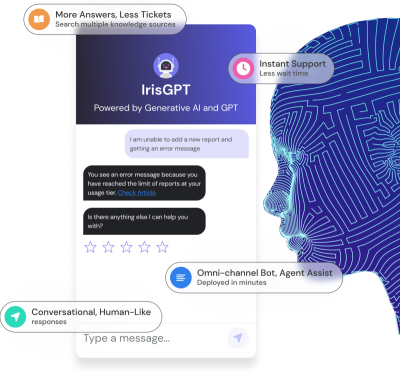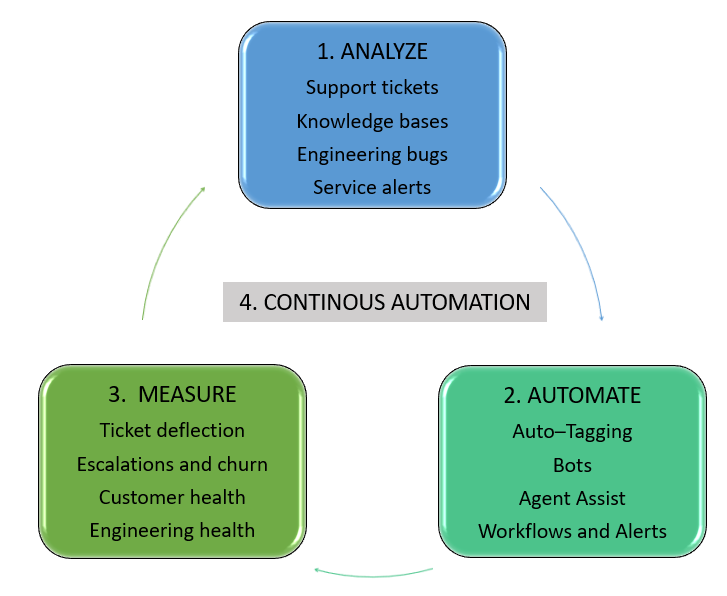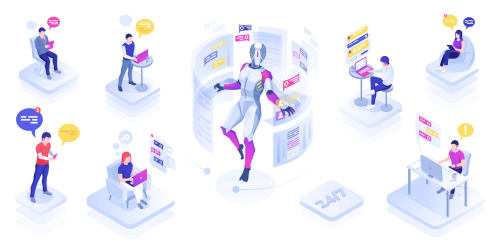Customer Self Service Automation And Its Benefits in Customer Support
What is Customer Self-Service Automation?
Self-service -wherein an end user can accomplish tasks or access information without direct assistance from a customer service representative has been a popular choice for automated customer service and support for quite some time. A typical use case for this is chatbots, email assistance, and automated conversational IVRs. These have been used for technical support, e-commerce, online banking, hospitality, telecommunications, and more, and they can connect with existing business processes for end-to-end automation. While this has been a popular choice for customer service teams and service desk teams for quite some time, the technology was primarily based on keyword matching. The advent of Generative AI, with its ability to get trained on vast data sets and generate accurate human-like responses, has opened up an opportunity for organizations to vastly improve the efficacy of their support automation workflows. This article explores how organizations can best use and optimize Generative AI for customer self-service automation.
What is Generative AI for automated customer self-service?
Generative AI for customer self-service automation refers to using generative artificial intelligence techniques to automate processes and enhance self-service solutions. This involves using AI-powered models to generate content and responses that can assist users in performing tasks, accessing information, or troubleshooting issues without a direct customer service representative’s intervention. The goal of employing generative AI in customer self-service automation is to trigger business processes and enhance the efficiency, effectiveness, and user experience of self-service technology. By automating content generation and responses, businesses can provide users with quick and accurate solutions, reduce the need for manual intervention, and ensure consistent and high-quality assistance around the clock.
Benefits of customer self-service automation
Using Generative AI in customer service automation and self-service automation tools can offer several benefits that enhance the efficiency, effectiveness, and overall user experience of customer service management and support and self-service systems. Here are some of the key advantages:
24/7 Availability: Generative AI-powered systems can provide assistance and solutions to users around the clock, eliminating the constraints of business hours and time zones. This ensures that users can access support whenever they need it.
Rapid Responses: Generative AI can instantly generate responses to customer queries and issues, reducing user waiting times and providing quick solutions to their problems.
Scalability: Automated support powered by generative AI can handle a large volume of inquiries simultaneously, allowing businesses to scale their support services without necessarily hiring additional human staff.
Consistency: Generative AI ensures consistent responses and solutions, minimizing the variability that can arise when different customer service team members handle similar issues.
Reduced Workload for Human Agents: By automating routine and repetitive tasks, generative AI frees up human customer service reps to focus on more complex and high-value interactions that require empathy, creativity, and critical thinking.
Quick Problem Resolution: AI-powered support can offer step-by-step troubleshooting guides and solutions, helping users resolve issues independently and reducing the need for human intervention.
Personalization: Generative AI can analyze user data and preferences to tailor responses and recommendations, providing a personalized and relevant support experience.
Language Support: Generative AI can offer support in multiple languages, ensuring that users from diverse linguistic backgrounds can access assistance in their preferred language.
Enhanced Self-Service: Generative AI can generate content for FAQs, knowledge bases, and self-help articles, empowering users to find solutions independently.
Cost Efficiency: Implementing generative AI in support automation can potentially reduce operational costs by decreasing the need for a large customer support workforce.
Consistent Training: Generative AI can ensure that support agents are provided with consistent training materials and resources, contributing to a standardized approach to customer support.
Adaptability: Over time, generative AI models can learn from user interactions and improve their responses, adapting to changing user needs and providing more accurate and helpful information.
Handling Peak Loads: During periods of high customer demand, such as product launches or promotions, generative AI can help manage increased support inquiries effectively.
Examples of customer self-service automation
Some critical use cases can benefit from Generative AI in customer self-service automation tools.

Virtual Agents for text and voice conversations
A typical use case for this is chatbots, email assistance, and automated conversational IVRs. These have been around since the early 2000s and typically used keyword matching. GPT leapfrogs this use case by, Training bots on large datasets that understand natural language intents (emotion, paraphrases) to provide a more natural communication. Gathering more context and relevant customer data points from large datasets. Do reasoning and adjust responses to be more customer-focused. Generative AI thus helps deliver contextually relevant answers for customer queries, such as frequently asked questions, troubleshooting guides, and product information.
Enhanced Knowledge Base Lookups and Content Expansion
Knowledge workers have traditionally written knowledge base articles. These are static and do not typically adapt to the customer's unique situation. With Generative AI, recognizing a new ticket or a solution that has not been previously addressed becomes more straightforward. Given its familiarity with an organization's products and services (discussed in the next use case), it can generate articles for internal use or even dynamic content that caters to your customers' context and a company's brand and style. Generative AI can automatically generate new articles or entries for knowledge bases, helping users find relevant information quickly. These knowledge base articles along with automation tools can power customer self service portals to deflect tickets and power proactive customer self service tools. Customer self service portal is one of the most impactful self service channels.
Model training and tuning for enhanced support experiences
Generative AI can enhance support experiences by customer interactions and training complex machine learning models to deliver tailored experiences that include,
Personalization: This involves customizing the model to a specific user or group of users to enhance its accuracy and effectiveness.
Product terminology is a specialized vocabulary or set of terms unique to a business or industry.
Multimodal input: This refers to using multiple forms of input, such as text, images, and audio, to train the model.
Language Translations
Generative AI can translate content in real time, enabling users to access information or interact with services in their preferred language. Language translations are indispensable in modern customer support, facilitating seamless communication between businesses and their global clientele. In an increasingly interconnected world, businesses must cater to customers from diverse linguistic backgrounds, necessitating the use of translation services to break down language barriers. By employing advanced translation technologies and skilled linguists, customer service agents and support teams can efficiently handle inquiries, complaints, and feedback in multiple languages in just a few clicks, ensuring that all customers receive timely and accurate assistance regardless of their native tongue. Effective language translations in customer support not only enhance customer satisfaction but also demonstrate a commitment to inclusivity and accessibility, ultimately fostering stronger relationships and loyalty with a global customer base.
Custom prompts and settings for support
With Generative AI, organizations can adjust key communication settings in automated jobs to deliver custom customer experiences; some examples of what can be tweaked in automated processes,
Formality - You can train a GPT model to use formal or informal language, depending on your company's brand identity and user preferences. For instance, a financial institution may prefer more formal language, while a fashion brand may opt for more casual language.
Empathy - Although AI technologies are not typically empathetic, you can fine-tune GPT's language to understand the user's emotions better, creating a more supportive and compassionate customer experience.
Politeness - In most customer service scenarios, GPT must use polite language and avoid offensive or insensitive language.
Clarity - Generally, you'll want GPT to use clear and concise language without technical jargon or overly complicated wording.
Brand Voice - By using a consistent brand voice, GPT can provide a more cohesive service offering, a significant advancement in the field of LLMs. Maintaining your company's tone and language can help build a stronger brand identity.
Implementing Customer Self-Service Automation
Implementing customer self-service automation requires careful planning and execution of IT teams to ensure its effectiveness and seamless integration into the business users' existing support systems. Here are key steps to consider:
1. Assessing Customer Needs: Begin by understanding your customers' preferences, pain points, and the types of inquiries and service requests they commonly have. This analysis will guide the selection of self-service automation tools, IT services, and features that best meet their needs.
2. Selecting the Right Tools: Choose self-service automation tools that align with your customers and business teams' preferences and your business objectives. Consider factors such as user interface design, integration capabilities, and scalability to ensure a seamless experience for both customers and support teams.
3. Designing User-Friendly Interfaces: Create intuitive and easy-to-navigate interfaces for self-service platforms, and digital tools, such as knowledge bases, FAQs, and chatbots. Clear labeling, search functionality, and multimedia content can enhance user engagement and satisfaction.
4. Training and Educating Customers: Educate customers on how to use their self-service automations options effectively through tutorials, FAQs, and onboarding materials. Encourage adoption of self service automation applications by highlighting the benefits of self-service, such as faster resolution times and 24/7 availability.
5. Measuring and Optimizing Effectiveness: Continuously monitor the performance of self-service automation tools using key metrics such as usage rates, resolution times, and customer feedback. Use this data to identify areas for improvement and optimize the self-service experience over time.
By following these steps, businesses can successfully implement customer self-service automation, empowering customers to find answers and solutions independently while freeing up support teams to focus on more complex issues and strategic initiatives.
Why IrisAgent for Self Service Automation?
IrisAgent has been leveraging Generative-AI for customer self service automation via automated tagging routine business requests, workflows, and answers. IrisGPT is a customer-facing bot and an agent-assist tool that scans support-related data sources - public-facing help centers and FAQs. It also scans the entire data repository of support operations - support ticket histories, slack histories, bugs, articles, open tickets, and more. It generates a human-like conversation that can resolve customers' issues without human interaction, particularly for repeatable or previously solved issues, such as "How do I reset my password?". IrisAgent's customer self service portals can be leveraged to deflect support tickets on help desk call center pages and ticket submission forms and to track ongoing customer requests. Our latest update with the integration of GPT has made GenAI with IrisAgent even more effective, with the ability to uncover the true source of issues, reduce escalations by 60%, and automatically respond to 35% of all tickets. And the best part? IrisGPT is multilingual and supports more than 50+ major languages to serve your customers across the globe better.
Conclusion of Self-Service Automation and Its Benefits
In summary, using Generative AI for customer self-service can automate up to 60% of customer-initiated tasks, inquiries, or support tickets. The responses are human-like, fast, and accurate. This improves CSAT and also saves time and money for an organization. With rapid advancements in Generative AI, self-service automation tools are poised to transform support automation. IrisAgent is at the forefront, having tailored Generative AI for the support use case. IrisAgent AI-driven Customer Self-Service - self-service automation portal - with automated tagging, answers, and workflows along with IrisGPT can help organizations initiate their AI journey for Customer Support.
Customer self-service automation: Frequently Asked Questions
What is customer self-service automation?
Customer Self-service automation - wherein an end user can accomplish manual tasks or access information without direct assistance from a customer service representative has been a popular choice for customer service and support for quite some time. A typical use case for this is chatbots, email assistance, and automated conversational IVRs. These have been used for technical support, e-commerce, online banking, hospitality, telecommunications, and more. While this has been a popular choice for quite some time, the technology was primarily based on keyword matching.
What are some best practices in self-service automation?
In customer support, effective self-service automation hinges on several best practices. Designing an easily navigable interface with intuitive user interfaces is paramount, ensuring users can effortlessly access the information they seek. Tailoring the experience through personalized recommendations and solutions adds an extra layer of value, enhancing user engagement. Robust error management mechanisms should be in place to tackle any hiccups users might encounter during their self-service journey. Finally, establishing a continuous feedback loop enables the most self service portals to evolve and improve, aligned with user needs and expectations.
How can business partners benefit from automated self-service?
Business partners can reap numerous benefits from embracing automated self-service in customer support. By providing an intuitive interface, partners can swiftly access relevant information and solutions, enhancing efficiency. Personalized automation tailors the support experience in day-to-day business, catering to specific partner needs and fostering stronger relationships. Automated error handling ensures smooth interactions, minimizing disruptions and delays in partner operations. Furthermore, a well-implemented feedback loop enables continuous improvement, aligning the self-service system with partner preferences and optimizing overall collaboration between business leaders.
Common mistakes businesses make when implementing self-service automation solutions
Businesses can stumble into common pitfalls when implementing self-service automation solutions in customer support. Overcomplicating the interface can confuse users, leading to frustration and abandonment of the self-service option. Neglecting personalization might result in a generic experience, failing to cater to diverse user needs. Inadequate error handling could leave users stranded without assistance when issues arise. Lastly, failing to gather and incorporate user feedback hampers the self-service process and the system's evolution and adaptation to user expectations, ultimately hindering the self service best practices and its effectiveness.




